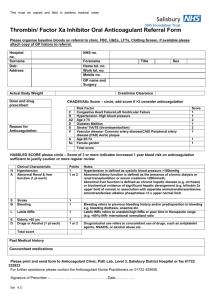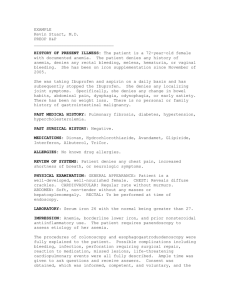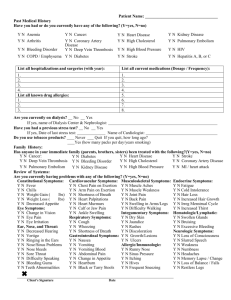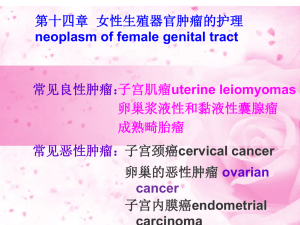Drugs acting on the blood and blood
advertisement
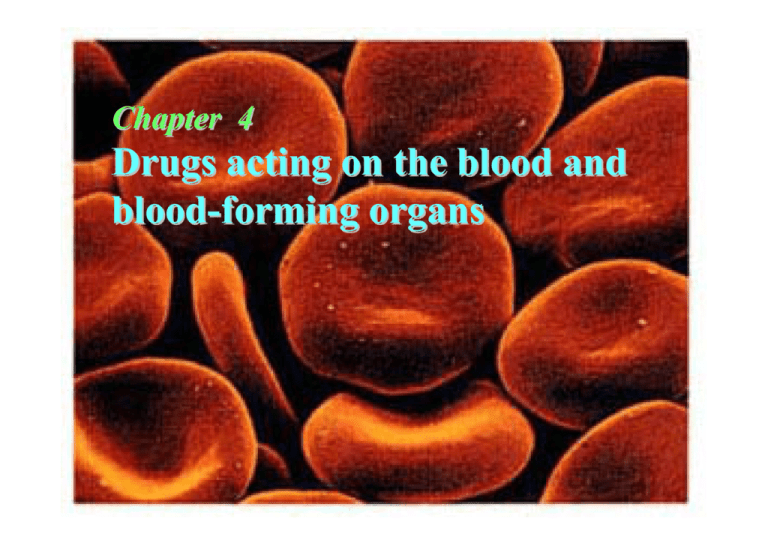
Chapter 4 Drugs acting on the blood and blood-forming organs Drugs affecting the blood and bloodforming organs Coagulation - bleeding Anticoagulant drugs(抗凝血药) Antiplatelet drugs (抗血小板药) Thrombolytic drugs (溶栓药) Drugs for treatment of bleeding (止血药) Blood cell growth Drugs for treatment of anemia(抗贫血药) Hematopoietic growth agents(造血细胞药) Blood volume Drugs for treatment of hypovolemia(血容量 扩充药) A. Anticoagulant drugs A. Anticoagulant drugs Heparin 肝素 Low molecular weight heparin 低分子肝素 Coumarins 香豆素类 warfarin 华法林 dicoumarol 双香豆素 acenocoumarol 醋硝香豆素 Thrombosis injures vital organs 外源性 (组织损伤) 内源性 (血管壁损伤) Stage I Stage II Stage III II I IIa Ia Major reactions of blood coagulation Coumarins A. Anticoagulant drugs Heparin 肝素 Molecular weights: 3~30 kDa; mean 15 kDa A. Anticoagulant drugs 1. Pharmacological effects (1) Anticoagulation Increasing the activity of AT III: The AT III inhibiting the activity of the activated IIa, VIIa, IXa, Xa, XIIa, etc. Rapid and short (2~4 h) Effective both in vitro and in vivo. more rapid Example of the effect of heparin A. Anticoagulant drugs (2) Anti –atherosclerosis blood lipids protecting endothelial cells inhibiting the hypertrophy of smooth muscle cells (3) Other effects: Antiinflammatory, antioxydant effects, etc. A. Anticoagulant drugs 2. Clinical uses (1) Thrombosis: pulmonary emboli, deep vein thrombosis, cardiac infraction, etc. (2) Cardiac ischemia: high-risk patients (3) Disseminated intravascular coagulation (DIC): early use. (4) Prevention of coagulation in vitro: cardiovascular surgery, hemodialysis, cardiac canula, etc. A. Anticoagulant drugs 3. Adverse effects (1) Bleeding (at higher doses) Protamine is the inhibitor of heparin. 1 mg (protamine 鱼精蛋白) = 100 U (heparin) (2) Thrombocytopenia (血小板减少): warfarin should be substituted if the platelet count falls (3) Others: allergy, local necrosis, long-term use: alpecia (脱发), osteoporosis (骨质疏松), etc. A. Anticoagulant drugs Low molecular weight heparin Mean MW = 1~12 kDa Features: Stronger effects on Xa, XIIa than on IIa Stronger in inhibiting thrombosis/coagulation High bioavailability; Longer half -life Weak bleeding effects A. Anticoagulant drugs Warfarin 华法林 A. Anticoagulant drugs 1. Pharmacological effects (1) Mechanisms of action: antagonizing vitamine K, inhibiting of carboxylation of the glutamic acid residues of the factors II, VII, IX, X , and reducing the activated II, VII, IX, X (2) Properties: slowly and longer duration: effect appears after p.o. 1~3 days, and lasts for 4 days effective only in vivo Sites of warfarin action Factor II, VII, IX, X warfarin action Activated factor II, VII, IX, X COO- 氢醌型Vit K 环氧型Vit K A. Anticoagulant drugs 2. Clinical uses Anticoagulation in vivo 3. Adverse effects (1) Bleeding: vitamine K may antagonize the reaction; interrelaction with other agents (2) Necrosis of skin and parenchyma (软组织) (3) Liver injury 4. Drug interactions Plasma protein binding replacement Hepatic metabolism: inhibition potentiation B. Antiplatelet drugs B. Antiplatelet drugs Inhibition of platelet metabolisms Inhibitors of cyclic nucleotide phosphodiesterase: dipyridamole 双嘧达莫 (潘生丁) COX inhibitors: aspirin 阿司匹林 TXA2 receptor antagonists and TXA2 synthetase inhibitors: ridogrel 利多格雷, picotamide 匹可托安 Activators of adenosine cyclase: epoprostenol 依前列醇 Inhibition of ADP-induced platelet activation ticlopidine 噻氯匹定 Gp IIb/IIIa receptor antagonists abciximab 阿昔单抗 (C7E3Fab) B. Antiplatelet drugs Aspirin 阿司匹林 Acetylsalicylic acid 乙酰水杨酸 COOH O O C Aspirin 阿司匹林 CH3 B. Antiplatelet drugs small doses (30~100 mg/d): inhibiting TXA2 synthesis, preventing thrombosis. used to treat ischemic heart disease, reduce the mortality of myocardiac infarction, and prevent cerebral thrombosis. larger doses: inhibiting PGI2 synthesis, promoting thrombosis. PGI2: vasodilation and platelet depolymerization (血小板 解聚). The mechanism of aspirin: Target enzymes acetylated C. Thrombolytic drugs C. Thrombolytic drugs C. Thrombolytic drugs Streptokinase(SK)(T1/2 = 23 min; ) Urokinase(UK) (T1/2 = 15 min; ) Tissue plasminogen activator ( t-PA,组织 纤溶酶原激活剂 ) i.v. T1/2 = 3~8 min t-PA (+) Action of thrombolytic drugs C. Thrombolytic drugs Common adverse effects bleeding antidotes: antifibrinolytic drugs Thrombolysis Bleeding D. Drugs for treatment of bleeding D. Drugs for treatment of bleeding Vitamine K Carboxylation of the glutamic acid residues of factors II, IIV, IX, X, protein C. Preventing bleeding with vitamine K deficiency or warfarin-induced bleeding Vitamin K Vitamin K D. Drugs for treatment of bleeding Thrombin-like agents thrombin, prothrombin complex, used for various bleeding D. Drugs for treatment of bleeding Drugs preventing activation of antifibrinolytics aprotinin (抑肽酶) tranexamic acid (AMCHA, 氨甲环酸) p-aminomethylbenzoic acide (PAMBA, 氨甲 苯酸) used for preventing the activation fibrinolysis and resultant bleeding Inhibiting plasminogen activation E. Drugs for treatment of anemia E. Drugs for treatment of anemia Anemia may result from the excess destruction of erythrocytes, and nutritional deficiencies (iron, minerals, cobalt, vitamin B12, folic acid, ascorbic acid, riboflavin, copper, zinc, etc. Iron: anemia due to loss of erythrocytes and iron deficiency Folic acid and vitamin B12: megaloblastic anemia Erythropoietin (EPO) promoting red cell proliferation and differentiation E. Drugs for treatment of anemia Iron ferrous sulfate 硫酸亚铁 ferric ammonium citrate 枸橼酸铁铵 1. Interaction with other drugs or diet in the GI tract 2. Used for anemia due to loss of erythrocytes and iron deficiency 3. Adverse effects: GI reactions, hypersensitivity Acute intoxication: severe CVS and GI reactions - treated with deferoxamine(去铁敏) E. Drugs for treatment of anemia Folic acid 1. Pharmacological effects Regulating nucleic acid, amino acid metabolism 2. Clinical uses Megaloblastic anemia; MTX-induced anemia 3. Adverse effects Rarely reported Vitamin B12 Co-factor of folic acid Important in maintaining neuron myelination E. Drugs for treatment of anemia Erythropoietin (EPO) rhEPO 1. Pharmacological effects Promoting red cell proliferation and differetiation 2. Clinical uses Anemia due to chronic renal failure with hemodialysis, radiotherapy, chemotherapy, AIDS, etc. 3. Adverse effects Hypertension, epilepsy, thrombosis, etc. Effect of EPO on red cell proliferation and differentiation F. Hematopoietic growth agents F. Hematopoietic growth agents Granulaocyte colony-stimulating factor G-CSF 粒细胞集落刺激因子 Granulaocyte/macrophage colony-stimulating factor GM-CSF 粒细胞/巨噬细胞集落刺激因子 Used for neutropenia (chemotheapy or radiotherapy), autologous bone marrow transplantation, myelodysplasia, aplastic anemia, AIDS-associated neutropenia Allergy, GI and hepatic injuries, local irritation, etc. G. Drugs for treatment of hypovolemia G. Drugs for treatment of hypovolemia Dextran 右旋糖酐(葡聚糖) Hydroxyethyl starch 羟乙基淀粉 Increasing blood volume Inhibiting platelet aggregation (~ MW 40,000) Osmotic diuretic effects hydroxyethyl starch 羟乙基淀粉 Enzymatic degradation and excretion of hydroxyethyl starch
